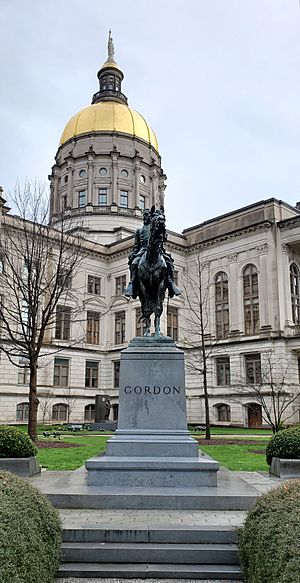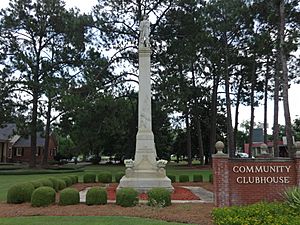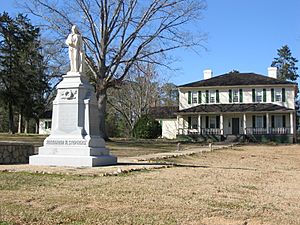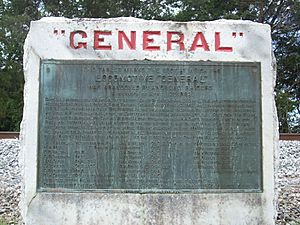List of Confederate monuments and memorials in Georgia facts for kids
This is a list of monuments and memorials in Georgia that honor the Confederate States of America (CSA). These symbols remember Confederate leaders or soldiers from the American Civil War. They include statues, flags, holidays, and names of places like schools and roads.
This list does not include simple historical markers or battlefield parks. It also does not include people connected to the start of the Civil War or white supremacy if they were not part of the Confederacy.
Georgia has a law that makes it hard to remove Confederate monuments. This law says it is against the rules to damage, move, or take away any memorials honoring military people from Georgia, the USA, or the Confederate States.
As of June 2020, there are at least 201 public places in Georgia with Confederate monuments.
Contents
- State Capitol Monuments
- State Flag
- State Holiday
- Stone Mountain (State Monument)
- Buildings Honoring Confederates
- Monuments in Public Places
- Places Named for Confederates
- Parks Honoring Confederates
- Public Works
- Roads Named for Confederates
- Schools Named for Confederates
- City Symbols
- Images for kids
- See also
State Capitol Monuments
The Georgia State Capitol grounds have several statues honoring Confederate figures:
- The Statue of John Brown Gordon (1907). Gordon was a Confederate general. He was also a leader in the "Lost Cause" idea, which made the South's role in the war seem more romantic. He was also known as a leader of the Ku Klux Klan in Georgia, a group that believed in white supremacy and used violence.
- The Statue of Benjamin Harvey Hill. He was a Confederate Senator.
- A statue of Joe Brown and his wife. Brown was Georgia's Confederate governor. After the war, he became a U.S. Senator.
- A plaque and tree honor William Ambrose Wright (1930). He was a Confederate Army lieutenant. He also worked for Georgia as a state comptroller for 50 years.
State Flag
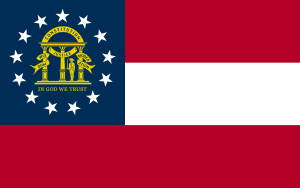
The current Georgia flag (since 2003) is based on the first national flag of the Confederacy. This flag was known as the "Stars and Bars".
State Holiday
- Confederate Memorial Day is celebrated in Georgia. It is on the last Monday in April. The state officially calls it "State Holiday."
Stone Mountain (State Monument)
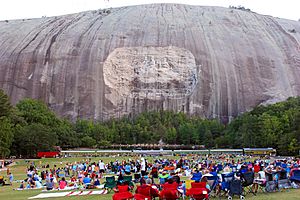
Stone Mountain is owned by the state of Georgia. When Georgia bought the land, it was set aside as a memorial to the Confederacy. Stone Mountain Park opened on April 14, 1965. This was exactly 100 years after President Lincoln was assassinated.
Stone Mountain was also where the Ku Klux Klan (the Second Klan) was restarted in 1915. They held cross-burning ceremonies on top of the mountain. For 50 years, an annual cross-burning ceremony happened there on Labor Day. Today, Stone Mountain is the most visited attraction in Georgia.
- Four flags of the Confederacy are flown at Stone Mountain.
- The Stone Mountain Memorial Lawn has 13 terraces. Each terrace represents one Confederate state. Each terrace flies the flag that state used during the Confederacy.
- The Stone Mountain Confederate Memorial Carving was made between 1923 and 1972. It is the largest carving of its kind in the world.
Buildings Honoring Confederates
- Athens: Allen D. Candler Hall at the University of Georgia (1901).
- Athens: Joseph E. Brown Hall at the University of Georgia (1932).
Monuments in Public Places
Many towns in Georgia have monuments honoring the Confederacy.
Courthouse Monuments
Many county courthouses in Georgia have Confederate monuments. These often include statues of soldiers or flagpoles.
- Blakely: Confederate Flagpole at the Early County Courthouse (1861).
- Butler: Taylor County Confederate Monument (1911).
- Decatur: The DeKalb County Confederate Monument (1911) is in front of the Old DeKalb County Courthouse. People have asked for it to be removed. The county commission voted to try and find a legal way to move it. This monument was removed in 2020.
- Newnan: The Coweta County Confederate Monument (1885) shows a soldier on guard. Its inscription honors "Our Confederate dead." A marker for Confederate Hospitals (1955) is also on the Courthouse Square.
- Oglethorpe: Confederate Monument (1923). It was first built as a fountain and later moved.
Other Public Monuments
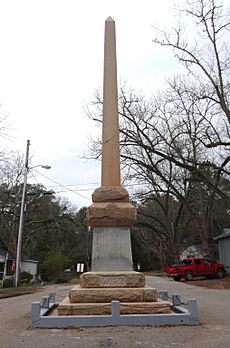
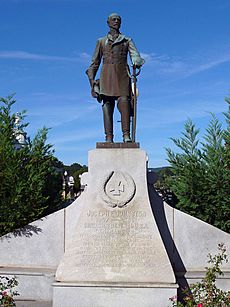
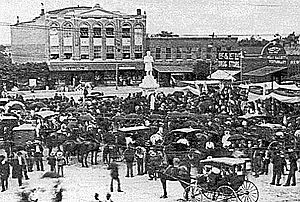
- Americus: Confederate Monument (1900).
- Andersonville: At the Andersonville National Historic Site, there is a monument to Henry Wirz (1909). He was the commander of the Confederate prison at Andersonville. Many Union soldiers died there from disease and hunger.
- Athens: Athens Confederate Monument (1872).
- Atlanta has several monuments:
- The Confederate Obelisk (1873) in Oakland Cemetery is the tallest object there. It honors "Our Confederate Dead."
- The Lion of the Confederacy (1894), also in Oakland Cemetery, honors "Unknown Confederate Dead." It was damaged by protestors in 2020 and removed in 2021.
- The Peachtree Battle Avenue Monument (1935) remembers the Battle of Peachtree Creek. A panel was added in 2019 to explain that it ignores the struggles of African Americans after the war.
- The Peace Monument (1911) in Piedmont Park shows a goddess with a Confederate soldier. It was damaged by protestors in 2017. A panel was added in 2019 to provide more context.
- The Eternal Flame of the Confederacy Monument (1939) is a gas streetlamp. It was part of the premiere of the movie Gone with the Wind. It is now at the Atlanta History Center.
- Augusta: The Augusta Confederate Monument (1878) has statues of Confederate Generals Robert E. Lee, Stonewall Jackson, T.R.R. Cobb, and W.H.T. Walker. The Four Southern Poets Monument (1913) honors poets linked to the Confederacy.
- Brunswick: A Confederate memorial in Hanover Square was removed in 2022. It will be moved to Confederate Soldiers Park in Waynesville.
- Dalton: Two memorials honor CSA Gen. Joseph E. Johnston. One is a statue (1912) in downtown Dalton.
- Elberton: The "Dutchy" statue (1898) was a granite monument meant to honor the Confederacy. It looked strange and was buried in 1900. It was dug up in 1982 and is now in the Elberton Granite Museum.
- Fort Oglethorpe: Chickamauga & Chattanooga National Military Park has many monuments to both Confederate and Union soldiers.
- Macon: The Bibb County Confederate Monument (1879) is in a downtown park.
- Milledgeville: The Confederate Memorial Fountain (1912) was put up by the United Daughters of the Confederacy. It has a soldier statue and honors the "Confederate soldier."
- Savannah:
- The Colonel Francis S. Bartow Bust (1902) is in Forsyth Park.
- The Confederate Monument (1879) in Forsyth Park will be renamed "Civil War Monument" in 2018.
Private Monuments
Some Confederate monuments are on private land.
- Albany: Confederate Memorial Park is owned by groups like the Sons of Confederate Veterans.
- Rome: Myrtle Hill Cemetery has monuments like the Nathan Bedford Forrest Monument (1909). Forrest was a Confederate general and an early leader of the Ku Klux Klan.
Places Named for Confederates
Many counties and towns in Georgia are named after Confederate figures.
- Bartow County, named for CSA Gen. Francis S. Bartow.
- Ben Hill County, named for CSA Sen. Benjamin Harvey Hill.
- Jeff Davis County, named for CSA President Jefferson Davis.
- Lanier County, named for Confederate poet and soldier Sidney Lanier.
- Stephens County, named for Alexander H. Stephens, Vice President of the Confederate States of America.
Parks Honoring Confederates
- Catoosa County: A monument (1977) to Confederate Gen. Bushrod Johnson is in Chickamauga and Chattanooga National Military Park.
- Cobb County: Kennesaw Mountain National Battlefield Park has a tribute (1917) to 14 generals from Georgia.
- Fitzgerald: Jefferson Davis Memorial Historic Site (1920).
Public Works
- Muscogee: Stonewall Jackson Dam.
Roads Named for Confederates
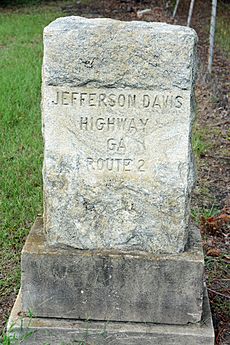
Many roads in Georgia are named after Confederate generals and leaders.
- Atlanta: Roads like Cleburne Avenue, Gordon Place, and Hardee Circle were named after Confederate generals. Confederate Avenue was renamed United Avenue in 2018. Forrest Street, named for Nathan Bedford Forrest, was renamed in 1980. Memorial Drive links downtown Atlanta to the Stone Mountain carving.
- Columbus: Robert E. Lee Drive.
- Eastman: Jefferson Davis Memorial Road.
- Fitzgerald: Many streets here are named after Confederate figures, such as Bragg Street, Lee Street, and Jackson Street.
- Jonesboro: Jeb Stuart Drive, Jeff Davis Drive, Robert E. Lee Parkway, and Stonewall Jackson Drive.
- Stone Mountain: Roads like Jefferson Davis Drive, Robert E. Lee Boulevard, and Stonewall Jackson Drive are found here.
- Chatham County: The Immortal Six Hundred Memorial Highway is a part of US 80.
Schools Named for Confederates
Some schools in Georgia were named after Confederate figures.
- Atlanta: Joseph E. Brown Middle School is now Herman J. Russell West End Academy. A granite memorial to the Confederacy is in front of E. Rivers Elementary School.
- Brunswick: The Sidney Lanier Building at Glynn Academy was once Sidney Lanier Elementary School.
- Hazlehurst: Jeff Davis Elementary, High School, Middle School, and Primary School.
- Thomaston: Robert E. Lee High School.
City Symbols
- Trenton, Georgia: In 2002, Trenton adopted a city flag that included the Confederate Battle Flag. This happened after the state changed its own flag. A vote in 2005 confirmed the city's choice to keep this flag.
Images for kids
-
Patrick R. Cleburne statue, Ringgold
See also


